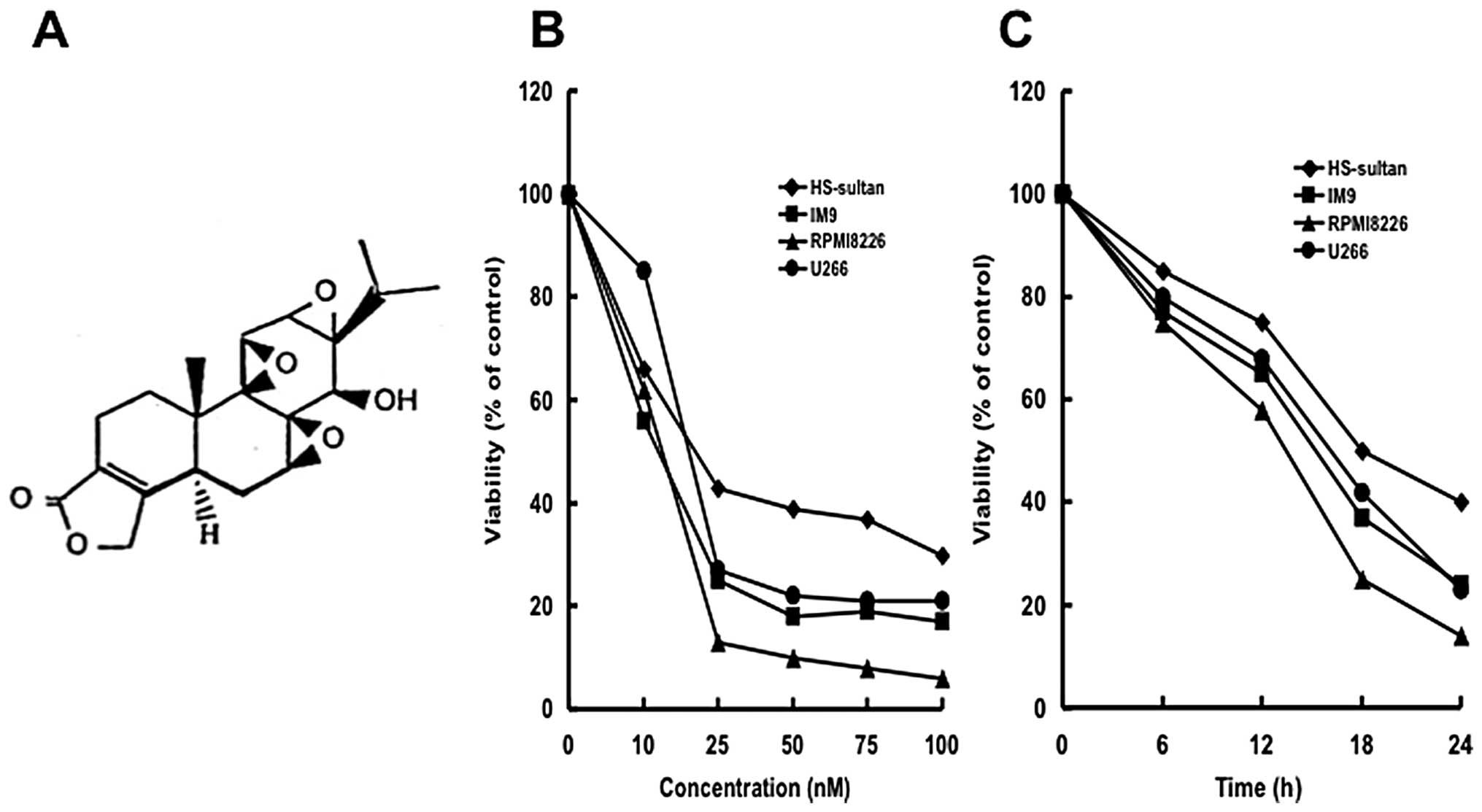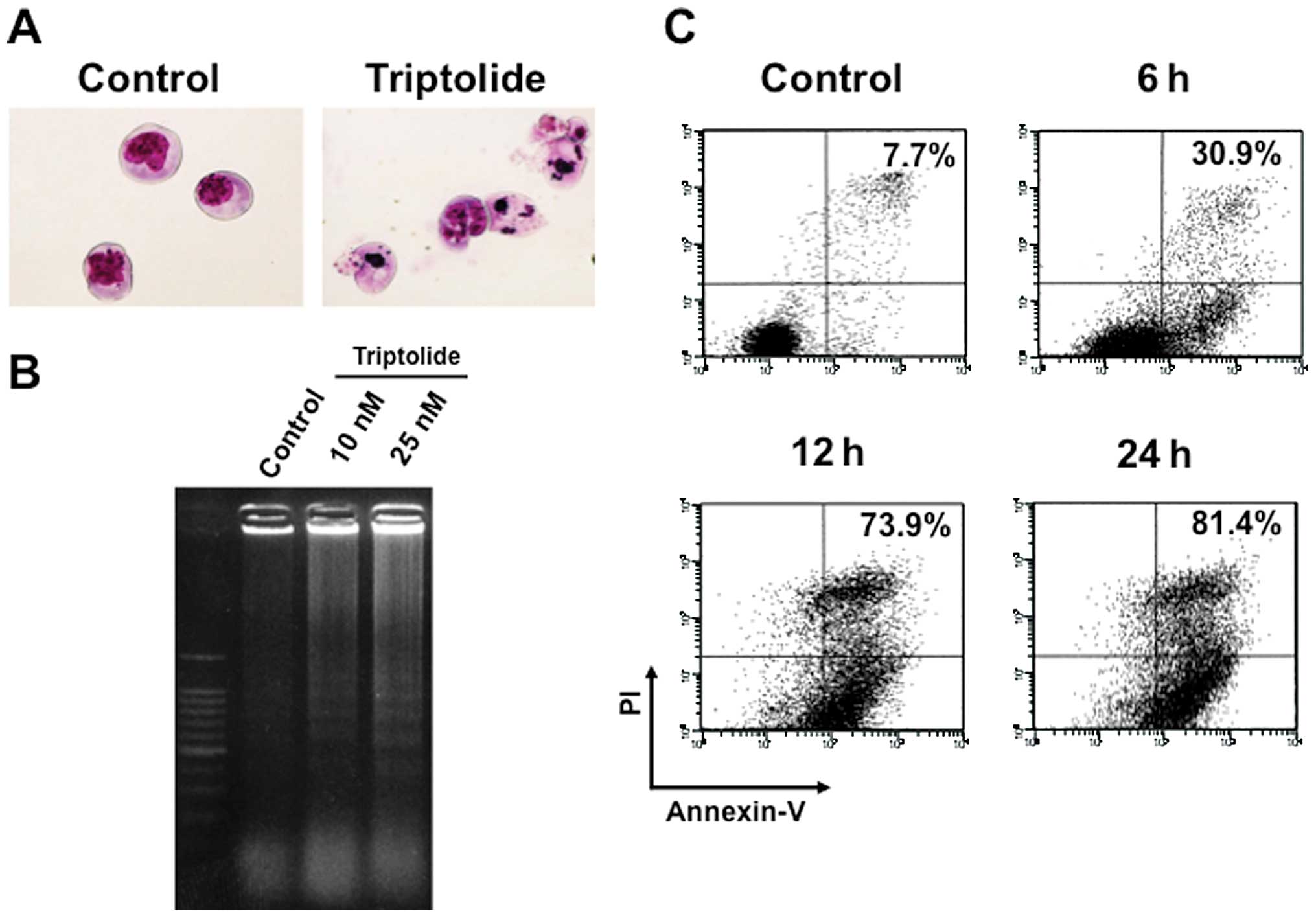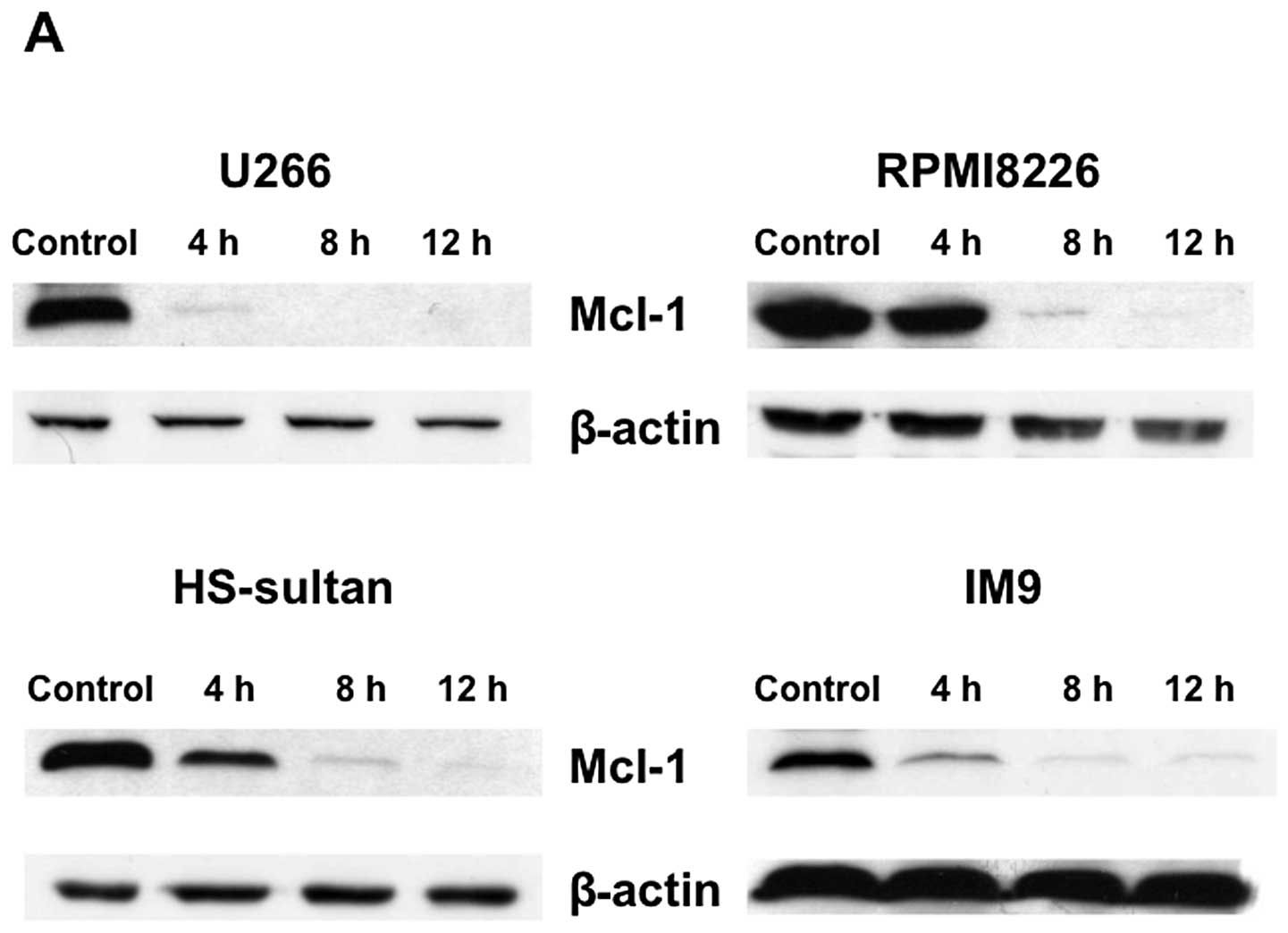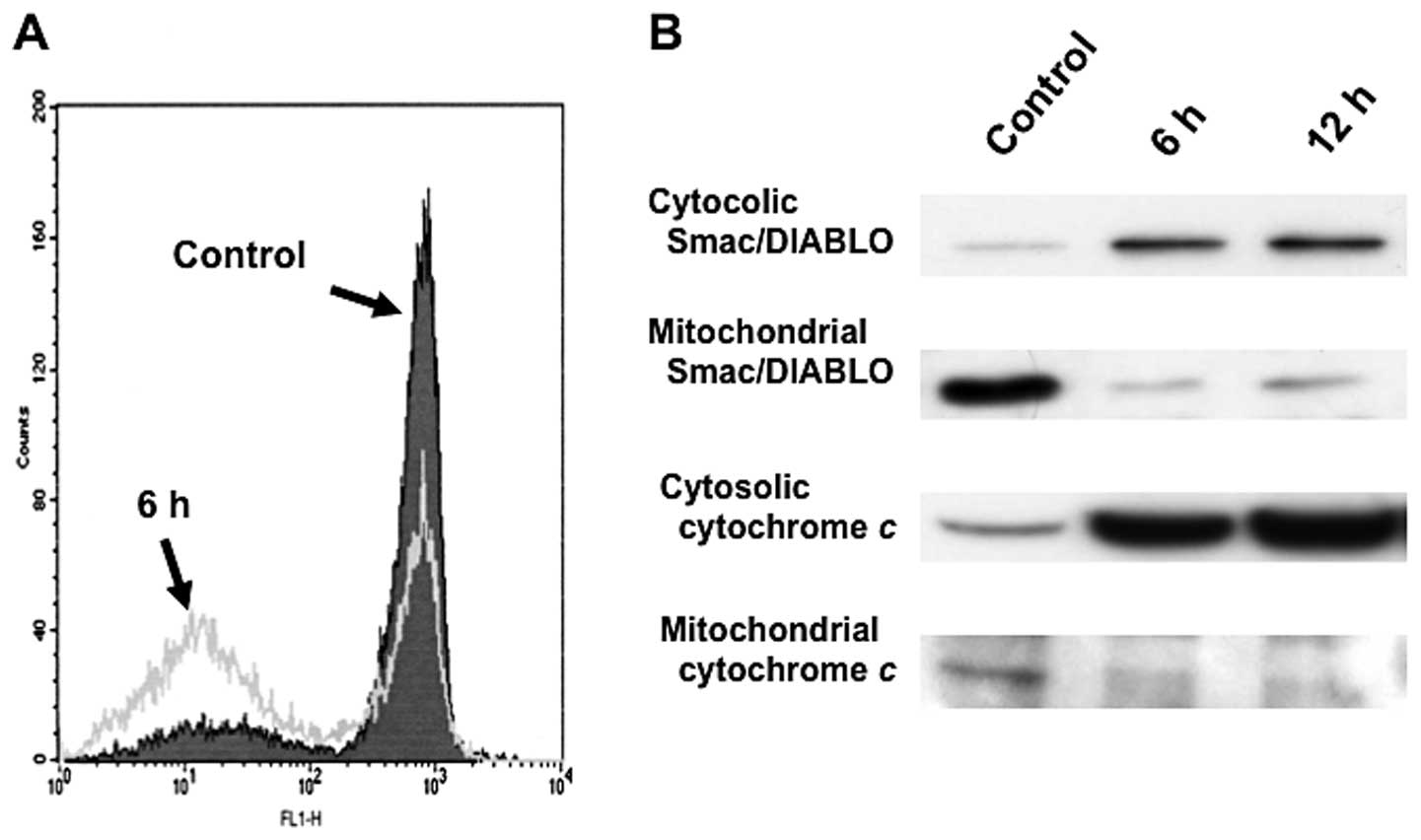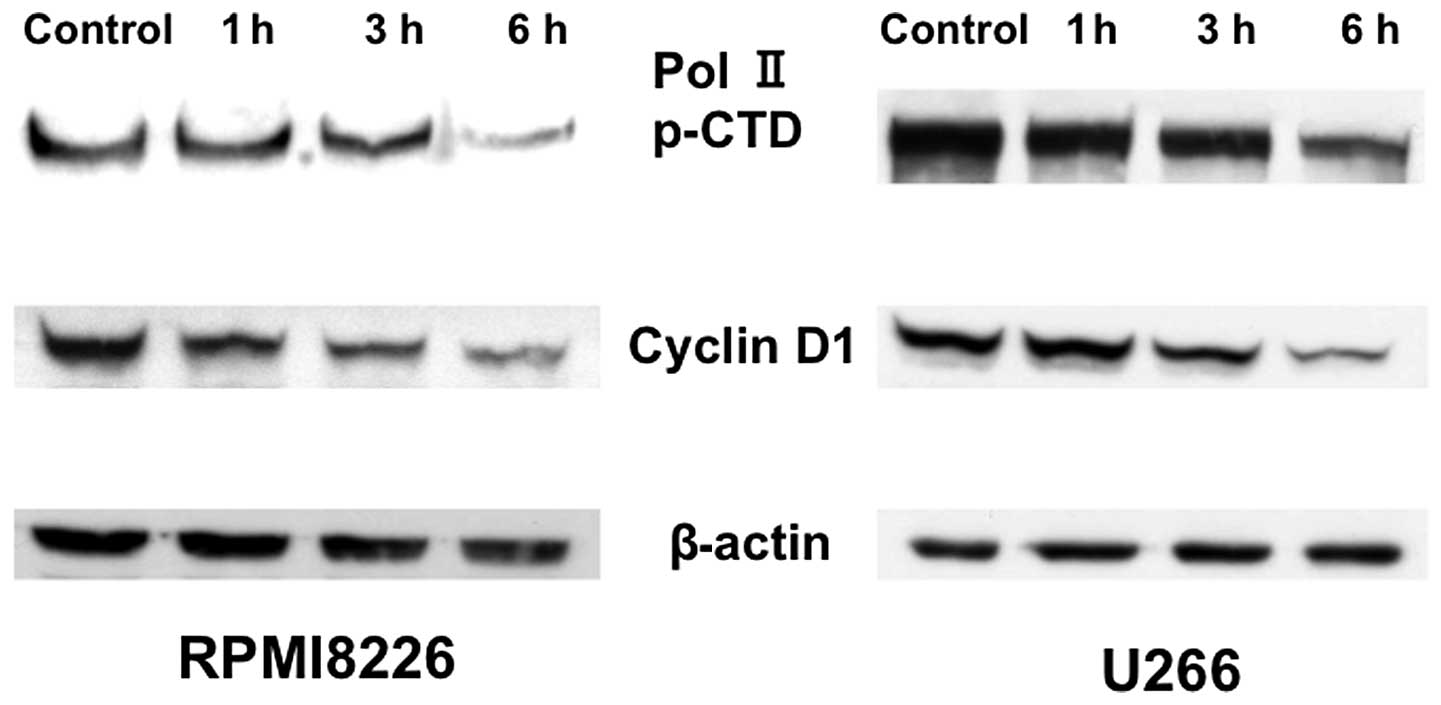Triptolide induces apoptotic cell death of multiple myeloma cells via transcriptional repression of Mcl-1
- Authors:
- Published online on: January 27, 2014 https://doi.org/10.3892/ijo.2014.2280
- Pages: 1131-1138
Abstract
Introduction
Multiple myeloma is a plasma cell malignancy that often remains fatal despite the use of high dose chemotherapy with hematopoietic stem cell transplantation (1). Most multiple myeloma patients are elderly; therefore, severe adverse effects and complications such as serious infection due to anticancer drugs are major problems in clinical practice. Since 2000, novel agents such as thalidomide, lenalidomide, and the proteasome inhibitor bortezomib have been introduced for the treatment of this disease and have remarkably improved patient outcome (2–4). However, adverse events and complications of these agents are often problematic in the clinical setting. In addition, prolonged use and repeated disease relapse may lead to the development of drug resistance in myeloma cells (5). Therefore, novel effective and less toxic therapeutic strategies are desired in order to improve clinical outcomes.
Extracts of the herb Tripterygium wilfordii Hook F have been used for more than two centuries as the traditional Chinese medicine to treat a variety of autoimmune and inflammatory diseases including rheumatoid arthritis (6,7). In addition, recent studies have demonstrated that triptolide has potential antitumor properties by inhibiting cell growth and inducing apoptotic cell death (8–11). Furthermore, triptolide shows antitumor effects on various hematological malignancies, and many studies have been performed to elucidate the molecular mechanism of triptolide-induced antitumor activities (12–15). Previous studies have shown that triptolide induces apoptosis of multiple myeloma cells mediated through the PI3K/Akt and NF-κB pathway and further associated with the MAPK pathway via mitochondrial cell death signaling and caspase activation (16,17). However, a more detailed mechanism of triptolide-induced apoptotic cell death in multiple myeloma cells remains unknown.
In the present study, we investigated the effects of triptolide on myeloma cells and showed that triptolide at low nanomolar concentrations induced apoptotic cell death in various multiple myeloma cell lines. We also examined the molecular mechanisms of triptolide-induced cell death in myeloma cells.
Materials and methods
Cells and cell culture
Human myeloma cell lines, HS-sultan, IM9, RPMI8226 and U266, were cultured in RPMI-1640 medium (Gibco BRL, Grand Island, NY, USA) supplemented with 10% fetal bovine serum (FBS) (Gibco BRL) in a humidified atmosphere with 5% CO2 at 37°C. These cell lines were obtained from the Japan Cancer Research Resources Bank (Tokyo, Japan). Cell morphology was evaluated using cytospin slide preparations with Giemsa staining and viability was assessed by trypan blue dye exclusion.
Reagents
Triptolide (Fig. 1A) was purchased from Sigma-Aldrich Japan (Tokyo, Japan) and was dissolved in PBS.
Cell proliferation assay
Cell proliferation was measured using an MTT proliferation assay kit (Roche Molecular Biochemicals, Mannheim, Germany). Cells were plated in 96-well culture plates at 5×104 cells/ml in a total volume of 100 ml with the indicated reagents. After a 2-day incubation, cellular proliferation was measured using the MTT assay. Mean and standard deviation were calculated from triplicate experiments.
Assays for apoptotic cell death
Cell death was determined by assessing morphological changes as well as by staining with Annexin V-FITC and PI labeling. Apoptotic cells were quantified with Annexin V-FITC and PI double staining by using a staining kit purchased from Pharmingen (San Diego, CA, USA). In addition, induction of apoptotic cell death was detected using a DNA fragmentation assay. Cells (1×106) were harvested and incubated in a lysis buffer [10 mM Tris-HCl (pH 7.4), 10 mM EDTA, 0.5% Triton-X] at 4°C. After centrifugation, supernatants were collected and incubated with RNase A (Sigma) at 50 mg/ml and proteinase K (Sigma) for 1 h at 37°C. The DNA samples was elevtrophoresed on a 2% agarose gel and visualized with ethidium bromide staining. The mitochondrial transmembrane potential (Δψm) was determined by flow cytometry (FACSCalibur; Becton-Dickinson, San Jose, CA, USA). Briefly, cells were washed twice with PBS and incubated with 1 mg/ml Rhodamine-123 (Sigma) at 37°C for 30 min. Rhodamine-123 intensity was determined by flow cytometry.
Cell cycle analysis
Cells (1×105) were suspended in hypotonic solution [0.1% Triton X-100, 1 mM Tris-HCl (pH 8.0), 3.4 mM sodium citrate, 0.1 mM EDTA] and stained with 50 mg/ml of PI. DNA content was analyzed by flow cytometry and the population of cells in each phase of the cell cycle was determined using ModiFIT software (Becton-Dickinson).
Caspase activation assays
The activation of caspase-3 was analyzed using a caspase-3 assay kit from BD Biosciences (San Jose, CA, USA). Briefly, the FITC-conjugated antibody against the active form of caspase-3 provided in the kit was used for FACS analysis according to the manufacturer’s instructions (BD Biosciences).
Reverse transcription-polymerase chain reaction (RT-PCR) analysis
Total cellular RNA was extracted using the RNeasy Mini kit (Qiagen, Valencia, CA, USA) according to the manufacturers’ instructions. Ten pmol of primers for Mcl-1 (forward, 5′-GCCAAGGACACAAAGCCAAT-3′; and reverse, 5′-AACT CCACAAACCCATCCCA-3′) were used in the PCR reactions. Primer sets for β-actin (forward, 5′-TCCTTCTGCATCCTG TCGGCA-3′; and reverse, 5′-CAAGAGATGGCCACGGCT GCT-3′) was used as the internal control. After an initial denaturation at 94°C for 2 min, 30 cycles of 30 sec at 94°C, 30 sec at 54°C, 1 min at 72°C, and final extension at 72°C for 7 min were performed using the Superscript III First-Strand Synthesis System for RT-PCR (Invitrogen Co., Carlsbad, CA, USA). The PCR products were electrophoresed in 2% agarose gels.
Cell lysate preparation and western blotting
Cells were collected by centrifugation at 700 g for 10 min and the pellets were resuspended in lysis buffer (1% NP-40, 1 mM phenylmethylsulfonyl fluoride (PMSF), 40 mM Tris-HCl (pH 8.0), 150 mM NaCl), and incubated at 4°C for 15 min. Mitochondrial and cytosolic fractions were prepared with digitonin-nagarse treatment. Protein concentrations were determined using the protein assay DC system (Bio-Rad, Richmond, CA, USA). Cell lysates (20 μg protein per lane) were fractionated in 12.5% SDS-polyacrylamide gels prior to transfer to membranes (Immobilon-P membranes, Millipore, Bedford, MA, USA) using standard protocol. Antibody binding was detected using an enhanced chemiluminescence kit for western blotting detection with hyper-ECL film (Amersham, Buckinghamshire, UK). Blots were stained with Coomassie brilliant blue to confirm equal loading of protein extracts. The following antibodies were used in this study: anti-caspase 3, anti-caspase-8, anti-caspase-9, anti-cytochrome c (Pharmingen), Bcl-2, anti-Bcl-XL, anti-Mcl-1, anti-cyclin D1, anti-β-actin (Santa Cruz Biotech, Santa Cruz, CA, USA), anti-Bax, anti-Smac (second mitochondria-derived activator of caspases)/DIABLO (MBL, Nagoya, Japan), and anti-RNA polymerase II CTD (phosphor, serine 7) (Funakoshi Co. Ltd., Tokyo, Japan).
Statistical analysis
All data are presented as the mean ± SD. Statistical significance was examined using Student’s t-test analysis and p<0.05 was considered statistically significant.
Results
Triptolide inhibits cellular proliferation of various myeloma cells
We first examined whether triptolide inhibited cellular growth of myeloma cells (HS-sultan, IM9, RPMI8226 and U266 cells). Triptolide inhibited the cellular growth of all myeloma cells dose- (0–100 nM) and time (0–24 h)-dependently (Fig. 1B and C). Among the cells tested, RPMI8226 cells were the most sensitive to triptolide with an IC50 of 17 nM (Fig. 1B). Therefore, we used RPMI8226 cells for further experiments. Interestingly, cell growth was suppressed as early as 6 h with low concentrations with typical apoptotic morphology observed, including condensed chromatin and fragmented nuclei with apoptotic bodies (Fig. 2A).
Triptolide induces G1 cell cycle arrest followed by apoptotic cell death
The effects of triptolide on cell cycle progression were investigated using RPMI8226 cells. The cells were treated with 25 nM triptolide for the indicated times and analyzed for cell cycle distribution by means of flow cytometry. Cultivation with triptolide increased the population of cells in the G0/G1 phase with a reduction of cells in the S phase (Fig. 3). In addition, a strong induction of apoptosis was shown by the appearance of a haplodiploid DNA peak with sub-G1 DNA contents after triptolide treatment. These results indicate that triptolide led to cell cycle arrest at the G1 phase followed by apoptosis. We thus confirmed the induction of apoptosis by triptolide by means of DNA ladder formation and Annexin V/PI staining. DNA ladder formation was confirmed at time-points as early as 6 h by electrophoresis of genomic DNA extracted from RPMI8226 cells treated with 25 nM triptolide (Fig. 2B). Consistent with these results, Annexinn V-positive cells dramatically increased in a time-dependent manner (Fig. 2C), indicating that triptolide rapidly induced apoptotic cell death in RPMI8226 cells.
Triptolide induces caspase-dependent cell death in myeloma cells
Caspases are believed to play a central role in mediating various apoptotic responses. To address the apoptotic cell death pathway in triptolide-treated RPMI8226 cells, we next examined the activation of caspases by western blot analysis. The downregulation of procaspase-3, procaspase-9 and procaspase-8 were detected after treatment with 25 nM triptolide for the indicated times (Fig. 4A). To clarify the activation of caspase-3, the percentage of cells expressing the active form of caspase-3 was analyzed by FACS. After incubation with 25 nM triptolide for 6 h, the percentage of RPMI8226 cells expressing the active form of caspase-3 was increased (Fig. 4B). These results indicated that triptolide induces apoptotic cell death of myeloma cells via a caspase-dependent pathway.
Triptolide induces cell death of myeloma cells with downregulation of Mcl-1
To investigate the molecular mechanisms of triptolide-induced apoptosis in RPMI8226 cells, the expression of several apoptosis-associated proteins were examined. Mcl-1, a critical survival factor for myeloma cells, was down-regulated with triptolide treatment in various myeloma cells (Fig. 6A). In contrast, triptolide did not modulate the levels of pro-apoptotic Bax or anti-apoptotic Bcl-2 and Bcl-XL proteins in RPMI8226 cells (data not shown).
Triptolide-induced death signaling is mediated through the mitochondrial pathway
Recent studies have suggested that mitochondria play an essential role in death signal transduction. Mitochondrial changes, including permeability transition pore opening and the collapse of the mitochondrial Δψm, result in the release of cytochrome c into the cytosol, which subsequently causes cell death by the activation of caspases (19). After treatment with 25 nM triptolide for 3 h, low Rh123 staining in RPMI8226 cells indicated an increase in the loss of mitochondrial Δψm (Fig. 5A). The loss of Δψm appeared in parallel with the activation of caspase-3 and caspase-9, as well as with apoptosis. In addition, triptolide induced a substantial release of various mitochondrial apoptogenic proteins, cytochrome c, Smac/DIABLO from the mitochondria into the cytosol in RPMI8226 cells (Fig. 5B). These results suggest that mitochondrial dysfunction causes the release of cytochrome c, Smac/DIABLO into the cytosol; caspase-9 and caspase-3 were then activated, thereby propagating the death signal.
Triptolide downregulates Mcl-1 expression through a transcriptional mechanism in association with the inhibition of RNA polymerase II CTD phosphorylation
To address the mechanism underlying triptolide-induced downregulation of Mcl-1, expression of Mcl-1 mRNA was examined using RT-PCR (Fig. 6B). Expression of Mcl-1 mRNA was decreased by triptolide treatment in various myeloma cell lines (U266, RPMI8226, HS-sultan, and IM9) in a time-dependent manner. Reductions in Mcl-1 mRNA levels were observed at 25 nM triptolide by 2–4 h and roughly paralleled the extent of protein downregulation (Fig. 6). We next examined the phosphorylation of the RNA polymerase II C-terminal domain (CTD) by triptolide treatment. Exposure to triptolide inhibited phosphorylation of RNA polymerase II CTD at serine 7, consistent with the inhibition of cyclin D1 expression (Fig. 7). These results suggest triptolide blocks RNA polymerase II CTD phosphorylation to repress Mcl-1 transcription.
Discussion
Multiple myeloma is a plasma cell neoplasm derived from clonal B cell lineage cells. The development of new agents such as the proteasome inhibitor, bortezomib, and the immunomodulatory drugs, thalidomide and lenalidomide, has led to improved outcomes in patients with multiple myeloma (2–4). However, a high proportion of patients cannot expect long-term remission due to drug-resistance, minimal residual disease, or complications such as severe infections (1–4). Therefore, new potent therapeutic agents and substantial therapeutic advances are needed for the treatment of multiple myeloma.
Triptolide has been found to have potent anti-inflammatory, immunosuppressive and antitumor properties (6–11). Recent studies have suggested that triptolide inhibits NF-κB activity via downregulation of Bcl-2 expression and the inhibition of p53 transcription activity in various p53-wild-type human tumor cells (18–20). It has also been reported that triptolide has antitumor activity against hematological malignancies. Triptolide induces apoptosis in chronic myeloid leukemia (CML) cells via downregulation of BCR-ABL (21,22), and inhibits MDM2 in acute lymphoblastic leukemia (ALL) cells through a p53-dependent pathway (23). In multiple myeloma, it was reported that triptolide inhibits NF-κB and induces apoptosis in RPMI8226 and U266 myeloma cells (17). It has also been suggested that triptolide enhances PS-341-induced apoptosis via the PI3K/Akt/NF-κB pathways in human multiple myeloma cells (16) and overcomes dexamethasone resistance in myeloma through upregulation of IL-6-independent expression of glucocorticoid receptors (24). There have been many studies on the antitumor activity of triptolide; however, its mechanism of action remains unclear, especially with respect to multiple myeloma.
In the present study, we showed that triptolide induced G0/G1 cell cycle arrest followed by apoptotic cell death at low nanomolar concentrations in human multiple myeloma cells in association with the downregulation of Mcl-1 at the level of mRNA transcription, loss of mitochondrial transmembrane potentials (Δψm), the release of mitochondrial apoptotic proteins such as cytochrome c, Smac/DIABLO into the cytosol, and the activation of caspase-3 and caspase-9.
Recent studies have reported that the Bcl-2 family member, Mcl-1, plays a critical role in multiple myeloma pathogenesis and drug-resistance by preventing the activation of endogenous apoptotic pathways and may represent a promising therapeutic target (25–28). In addition, it has been reported that drug-induced generation of Mcl-1 fragments followed by c-Jun upregulation may also be a novel therapeutic approach (29). In our study, Mcl-1 protein levels rapidly decreased after triptolide treatment. This suggests that the loss of Mcl-1 expression may play a significant role in triptolide-induced apoptosis of myeloma cells. In addition, triptolide inhibited phosphorylation of RNA polymerase II CTD at serine 7, indicating that triptolide blocks RNA polymerase II CTD phosphorylation to repress Mcl-1 transcription elongation. Consistent with our data, it has been reported that triptolide inhibits de novo total RNA transcription in leukemic cells, and induces changes in the nuclear substructure that are associated with decreased RNA polymerase II CTD serine phosphorylation (30). Recently, the effects of triptolide on gene expression was examined using whole human genomic DNA microarrays and it was found that 4-h triptolide treatment upregulated 160 genes and downregulated 1,511 genes in the non-small cell lung cancer cell line A549 (31). Additionally, it was reported that triptolide significantly suppresses apoptosis related genes, such as XIAP, Bcl-2, Mcl-1, as well as cell cycle regulators including CDC25A, Polo-like kinases, in various human tumor cells (9,10,32). Taken together, our results and the previously published data indicate that triptolide suppresses a broad range of gene expression by inactivation of NF-κB and other signal transduction pathways, as well as by global suppression of transcription (33).
We also found that Smac was released from mitochondria to the cytosol during triptolide-induced apoptotic cell death in myeloma cells. Smac binds to XIAP and eliminates its inhibitory effect on caspase-9. Various anti-myeloma agents trigger the loss of Δψm, and the release of the mitochondrial apoptogenic proteins cytochrome c and Smac/DIABLO (34,35). It has also been reported that PS-341-induced apoptosis in myeloma cells is associated with activation of JNK, translocation of JNK from the cytosol to mitochondria, and release of Smac from mitochondria to the cytosol (36). Other studies showed that 2-methoxyestradiol (2ME2)-induced apoptosis in multiple myeloma cells is mediated by JNK activation and JNK-dependent release of Smac from mitochondria to the cytosol (37). Various studies have shown that stress-induced changes in Δψm correlate with an increase in reactive oxygen species (ROS) and the release of mitochondrial cytochrome c and Smac/DIABLO. The role of ROS in mediating apoptosis in various cancer cells is well established (34,38). The generation of ROS have been linked to the release of Smac or cytochrome c from mitochondria to the cytosol during apoptosis (39,40). Therefore, it will be important to address the effects of ROS on triptolide-induced apoptotic cell death in multiple myeloma cells.
Many natural products have been used as anticancer agents in a clinical setting, and have provided lead chemical structures with which to develop new agents with enhanced biological properties and decreased adverse effects (41). Natural compounds appear to be safer than popular chemotherapeutic agents; therefore, they might be useful in older patients or in immunocompromised patients because of their safety and lack of known toxicity. Furthermore, it would be useful to design clinical trials with myeloma patients to evaluate their anti-myeloma effects.
In conclusion, triptolide may have potential as a novel therapeutic agent to replace or augment the more cytotoxic agents currently used to treat myeloma patients. Further studies are warranted to evaluate this possibility.
Acknowledgements
We thank Chika Nakabayashi for her helpful technical assistance. This study was supported in part by the Ministry of Education, Culture, Sports, Science and Technology of Japan, and by the National Cancer Center Research and Development Fund of Japan (23-A-17).
References
|
Kyle RA and Rajkumar SV: Multiple myeloma. Blood. 111:2962–2972. 2008. View Article : Google Scholar : PubMed/NCBI | |
|
Palumbo A and Anderson K: Multiple myeloma. N Engl J Med. 364:1046–1060. 2011. View Article : Google Scholar | |
|
Boyd KD, Pawlyn C, Morgan GJ and Davies FE: Understanding the molecular biology of myeloma and its therapeutic implications. Expert Rev Hematol. 5:603–617. 2012. View Article : Google Scholar : PubMed/NCBI | |
|
Watanabe R, Tokuhira M and Kizaki M: Current approaches for the treatment of multiple myeloma. Int J Hematol. 97:333–344. 2013. View Article : Google Scholar : PubMed/NCBI | |
|
Kumar S, Lee JH, Morgan G, et al: Risk of progression and survival in multiple myeloma relapsing after therapy with IMiDs and bortezomib: a multicenter international myeloma working group study. Leukemia. 26:149–157. 2012. View Article : Google Scholar : PubMed/NCBI | |
|
Gu WZ and Brandwein SR: Inhibition of type II collagen-induced arthritis in rats by triptolide. Int J Immunopharmacol. 20:389–400. 1998. View Article : Google Scholar : PubMed/NCBI | |
|
Cibere J, Deng Z, Lin Y, et al: A randomized double blind, placebo controlled trial of tropical Tripterygium wilfordii in rheumatoid arthiritis: reanalysis using logistic regression analysis. J Rheumatol. 30:465–467. 2003.PubMed/NCBI | |
|
Shamon LA, Pezzuto JM, Graves JM, et al: Evaluation of the mutagenic, cytotoxic, and antitumor potential of triptolide, a highly oxygenated diterpene isolated from Tripterygium wilfordii. Cancer Lett. 112:113–117. 1997. View Article : Google Scholar : PubMed/NCBI | |
|
Yang S, Chen J, Guo Z, et al: Triptolide inhibits the growth and metastasis of solid tumors. Mol Cancer Ther. 2:65–72. 2003.PubMed/NCBI | |
|
Kiviharju TM, Lecane PS, Sellers RG and Peehl DM: Antiproliferative and proapoptotic activities of triptolide (PG490), a natural product entering clinical trials, on primary cultures of human prostatic epithelial cells. Clin Cancer Res. 8:2666–2674. 2002. | |
|
Owa C, Messina ME Jr and Halaby R: Triptolide induces lysosomal-mediated programmed cell death in MCF-7 breast cancer cells. Int J Women’s Health. 5:557–569. 2013.PubMed/NCBI | |
|
Carter BZ, Mak DH, Schober WD, et al: Triptolide induces caspase-dependent cell death mediated via the mitochondrial pathway in leukemic cells. Blood. 108:630–637. 2006. View Article : Google Scholar : PubMed/NCBI | |
|
Zhang C, Cui GH, Liu F, Wu QL and Chen Y: Inhibitory effect of triptolide on lymph node metastasis in patients with non-Hodgkin lymphoma by regulating SDF-1/CXCR4 axis in vitro. Acta Phramacol Sin. 27:1438–1446. 2006. View Article : Google Scholar : PubMed/NCBI | |
|
Carter BZ, Mak DH, Schober WD, et al: Triptolide sensitizes AML cells to TRAIL-induced apoptosis via decrease of XIAP and p53-mediated increase of DR5. Blood. 111:3742–3750. 2008. View Article : Google Scholar : PubMed/NCBI | |
|
Fuchs O: Transcription factor NF-κB inhibitors as single therapeutic agents or in combination with classical chemotherapeutic agents for the treatment of hematological malignancies. Curr Mol Pharmacol. 3:98–122. 2010. | |
|
Yang M, Huang J, Pan HZ and Jin J: Triptolide overcomes dexamethasone resistance and enhanced PS-341-induced apoptosis via PI3k/Akt/NF-κB pathways in human multiple myeloma cells. Int J Mol Med. 22:489–496. 2008.PubMed/NCBI | |
|
YinJun L, Jie J and YunGui W: Triptolide inhibits transcription factor NF-κB and induces apoptosis of multiple myeloma cells. Leuk Res. 29:99–105. 2005. | |
|
Jiang XH, Wong BCY, Lin MCM, et al: Functional p53 is required for triptolide-induced apoptosis and AP-1 and NF-κB activation in gastric cancer cells. Oncogene. 20:8009–8018. 2001.PubMed/NCBI | |
|
Lin J, Chen LY, Lin ZX and Zhao ML: The effects of triptolide on apoptosis of glioblastoma multiforme (GBM) cells. J Int Med Res. 35:637–643. 2007. View Article : Google Scholar : PubMed/NCBI | |
|
Zhou GX, Ding XL, Zhang H, et al: Apoptosis of human pancreatic cells induced by triptolide. World J Gastroenterol. 14:1504–1509. 2008. View Article : Google Scholar : PubMed/NCBI | |
|
Lou YJ and Jin J: Triptolide down-regulates bcr-abl expression and induces apoptosis in chronic myelogenous leukemia cells. Leuk Lymphoma. 45:373–376. 2004. View Article : Google Scholar : PubMed/NCBI | |
|
Shi Y, Jin Y, Cheng H, et al: Triptolide inhibits Bcr-Abl transcription and induces apoptosis in STI571-resistant chronic myelogenous leukemia cells harboring T315I mutation. Clin Cancer Res. 15:1686–1697. 2009. View Article : Google Scholar : PubMed/NCBI | |
|
Huang M, Zhang H, Jiu T, Tian D, Gu L and Zhou M: Triptolide inhibits MDM2 and induces apoptosis in acute lymphoblastic leukemia cells through a p53-independent pathway. Mol Cancer Ther. 12:184–194. 2013. View Article : Google Scholar : PubMed/NCBI | |
|
Yang M, Shen JK, Huang J, Du HP, Ma QL and Jin J: Interleukin-6-independent expression of glucocorticoid receptor is upregulated by triptolide in multiple myeloma. Leuk Lymphoma. 50:802–808. 2009. View Article : Google Scholar : PubMed/NCBI | |
|
Jourdan M, Veyune JL, De Vos J, Redal N, Couderc G and Klein B: A major role for Mcl-1 antiapoptotic protein in the IL-6-induced survival of human myeloma cells. Oncogene. 22:2950–2959. 2003. View Article : Google Scholar : PubMed/NCBI | |
|
Le Gouill S, Podar K, Harousseau JL and Anderson KC: Mcl-1 regulation and its role in multiple myeloma. Cell Cycle. 3:1259–62. 2004.PubMed/NCBI | |
|
Le Gouill S, Podar K, Amiot M, et al: VEGF induces Mcl-1 up-regulation and protects multiple myeloma cells against apoptosis. Blood. 104:2886–2892. 2004.PubMed/NCBI | |
|
Gomez-Bougie P, Wuillème-Toumi S, Ménoret E, et al: Noxa up-regulation and Mcl-1 cleavage are associated to apoptosis induction by bortezomib in multiple myeloma. Cancer Res. 67:5418–5424. 2007. View Article : Google Scholar : PubMed/NCBI | |
|
Fan F, Tonon G, Bashari MH, et al: Targeting Mcl-1 for multiple myeloma (MM) therapy: drug-induced generation of Mcl-1 fragment Mcl-1128-350 triggers MM cell death via c-Jun upregulation. Cancer Lett. 28–Oct;2013.Epub ahead of print. | |
|
Leuenroth SJ and Crews CM: Triptolide-induced transcriptional arrest is associated with changes in nuclear substructure. Cancer Res. 68:5257–5266. 2008. View Article : Google Scholar : PubMed/NCBI | |
|
Vispe S, DeVries L, Creancier L, et al: Triptolide is an inhibitor of RNA polymerase I and II-dependent transcription leading predominantly to down-regulation of short-lived mRNA. Mol Cancer Ther. 8:2780–2790. 2009. View Article : Google Scholar : PubMed/NCBI | |
|
Wan CK, Wang C, Cheung HY, Yang M and Fong WF: Triptolide induces Bcl-2 cleavage and mitochondria dependent apoptosis in p53-dependent HL-60 cells. Cancer Lett. 241:31–41. 2006. View Article : Google Scholar : PubMed/NCBI | |
|
Pan J: RNA polymerase an important molecular target of triptolide in cancer cells. Cancer Lett. 292:149–152. 2010. View Article : Google Scholar : PubMed/NCBI | |
|
Cai J and Jones DP: Mitochondrial redox signaling during apoptosis. J Bioenerg Biomemb. 31:327–334. 1999. View Article : Google Scholar | |
|
Chauhan D, Hideshima T and Anderson KC: Apaf-1/cytochrome c-independent and Smac-dependent induction of apoptosis in multiple myeloma cells. J Biol Chem. 276:24453–24456. 2001.PubMed/NCBI | |
|
Chauhan D, Li G, Hideshima T and Anderson KC: JNK-dependent release of mitochondrial protein, Smac, during apoptosis in multiple myeloma cells. J Biol Chem. 278:17593–17596. 2003. View Article : Google Scholar : PubMed/NCBI | |
|
Chauhan D, Li G, Hideshima T and Anderson KC: 2-methoxyestradiol overcomes drug resistance in multiple myeloma cells. Blood. 100:2187–2194. 2002. View Article : Google Scholar : PubMed/NCBI | |
|
Simon HU, Haj-Heyia A and Levi-Schaffer F: Role of reactive oxygen species (ROS) in apoptosis induction. Apoptosis. 5:415–418. 2000. View Article : Google Scholar : PubMed/NCBI | |
|
Hsu MJ, Sheu JR, Lin CH, Shen MY and Hsu CY: Mitochondrial mechanisms in amyloid beta peptide-induced cerebrovascular degeneration. Biochim Biophys Acta. 1800:290–296. 2010. View Article : Google Scholar : PubMed/NCBI | |
|
Monteiro JP, Oliveira PJ and Jurado AS: Mitochondrial membrane lipid remodeling in pathophysiology: A new target for diet and therapeutic interventions. Prog Lipid Res. 52:513–528. 2013. View Article : Google Scholar : PubMed/NCBI | |
|
Mann J: Natural products in cancer chemotherapy: past, present and future. Nat Rev Cancer. 2:143–148. 2002. View Article : Google Scholar : PubMed/NCBI |



